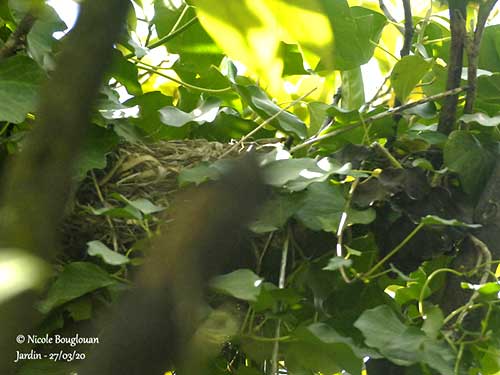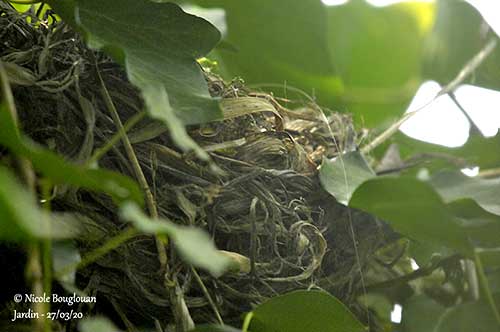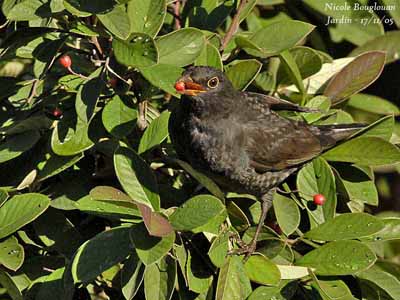
Common Blackbird
Turdus merula
Passeriforme Order – Turdidae Family
The Common Blackbird is common in cities and gardens, but it is always present in the countryside. It is sedentary in its habitat, and we are glad to see it all year round.
Its wonderful fluty song accompanies dawn and dusk in spring, but sometimes, its repeated alarm calls are so hard to hear, even if we know that the goal is to warn the youngs against a predator. It feeds on fruits, earth worms which it flushes out in a very skilful way, and it is not averse to sunflower seeds in winter.
Very territorial in breeding season, it is more gregarious in winter and small groups feed together. The nest is a masterpiece made of grass and mud, and lined with soft vegetation. The female builds the nest in about three days, in the fork of a tree, a hedge or a shrub.
BIOMETRICS:
Length: 24-27 cm; Weight: 85-105 g
DESCRIPTION:
The Common Blackbird is an elegant bird, rather territorial in breeding period. Its melodious song is appreciated by humans and it lives closer and closer to them.

The adult male has black and glossy plumage overall. Bill and eye-ring are yellow. The eyes are dark brown and the legs are blackish.
The female is a bit more reddish-brown, slightly mottled with paler tinge on the underparts. Her throat can be paler, separated from the face by an indistinct buffy-brown malar stripe. Bill is brownish with yellow base. Eyes and legs are dark brown.
Juvenile is dark brown, streaked with buff on the upperparts, and underparts slightly mottled too. Bill is brownish.
The young male of one year still keeps the brown flight feathers, whereas its dark bill turns yellow.
The Common Blackbird tends to suffer albinism. Some birds may have several white feathers contrasting with the black plumage. Albinism is the entire lack of pigment.
Several subspecies are distributed throughout the world, and differ by plumage colours and size. The general allure and the behaviour are the same.
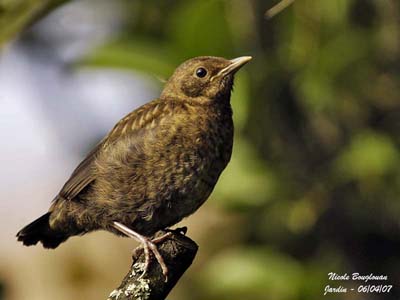
VOICE: SOUNDS BY XENO-CANTO
The Common Blackbird utters several kinds of calls according to the situation. If disturbed, it gives some low and slowly repeated “tchuc”. When alarmed, it utters shrills “tink-tink-tink” more or less quickly repeated. These calls may become hysterical in front of a dangerous predator.
The Blackbird’s song is very beautiful, made of clear and liquid notes. The song may vary from male to male, but the musical phrases are similar.
The song is fluty, high-pitched and strong, with short lower chirps, very pleasant to hear. These phrases end in brief ascending note. The whistles end in melodious trill.
It sings from high perch as soon as the breeding season starts.
HABITAT:
Common Blackbird lives in very varied habitats, from mountainous regions to big city centres. It frequents the open forests and their edges, cultivated areas, parks and gardens, if the cover is close for hiding.
It may be seen from sea level up to elevations between 500 and 2000 metres, according to the country where it lives.
RANGE :
Common Blackbird breeds in North Africa, and from Europe to India and southern China. Northern and eastern populations migrate for wintering in Egypt and south-east and west of Asia.
It has been introduced in Australia and New Zealand in the 1850s.
BEHAVIOUR:
The Common Blackbird feeds mainly on the ground. It turns the leaf litter to extract the invertebrates hidden below. It pecks and tears off the moss for the same reasons. When it moves, it runs on short distances, stops abruptly while turning the head sideway to detect the prey and hops while digging the ground with the bill to attract the worms. It also feeds in trees and bushes where it finds its preferred fruits and berries.
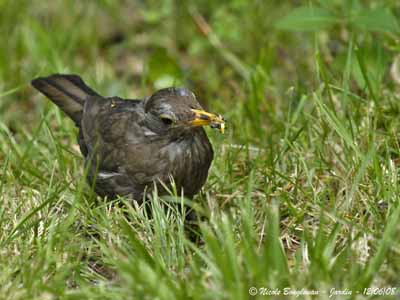
It often takes sun baths, flattened on the grass or the warm ground, with open bill and inclined head, and spread wings and tail.
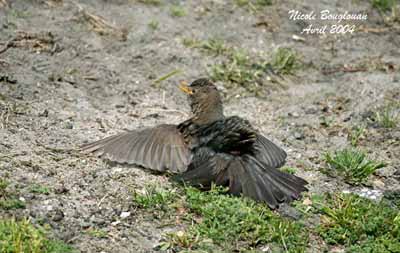
Common Blackbird comes close to habitations, victim of habitat degradation with the heavy deforestation. Now on our house doorsteps, it learned how to benefit from the remainders of bread or not consumed fruits, and its familiarity is always increasing.
The courtship displays start very soon in this species, often in February. The male sings at dawn. It fans its tail and raises it up vertically, while it draws back the head into the shoulders until resembling a black ball from where only the yellow bill appears. The female fluffs her neck and rump feathers in answer to the male displays. The pair is often formed as soon as the end of the year, but it is common to see several males displaying around only one female.
Common Blackbirds are territorial and strongly defend their territory, mainly in urban area where each pair has little space. Females may fight too, to defend a good nest-site.
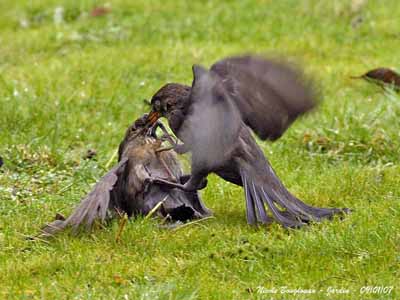
PERSONAL OBSERVATION:
I could attend a demonstration of defence of the territory in January last year between two females. The territory’s owner chased away other female passing too much close to the boundaries. The fight continued on the ground where I had to go to separate them, so much the combat was hard. Pecks and scratches were really strong. They stopped only when I was very close to them. They flew away while calling, but I am not sure about the end of this fight. They flew into a rage.
Males peck and scratch each other at some height above the ground (one to two meters) while fluttering in front to each other and while calling.
FLIGHT:
Common Blackbird usually flies low from the ground and often short distances with slow wing beats. On longer distances, the flight is direct and slightly undulating. It is able to fly long distance when migrating, and they travel in flocks at night.
REPRODUCTION:
Common Blackbird breeds in spring and it can produces three clutches.
The female builds a robust nest among the vegetation, at low height but well hidden, fixed in a three branches’ fork.
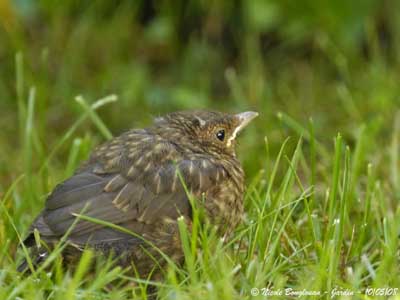
The chicks hatch 13 to 14 days later, covered with grey-brown down. They are actively fed by both adults, with fruits, insects and earth worms. The youngs leave the nest 13 to 14 days after hatching. They hide and climb into the surrounding vegetation where they are fed by both parents during two or three weeks more.
When the clutch includes until four chicks, each parent cares for two youngs within the parental territory, but in two different areas.
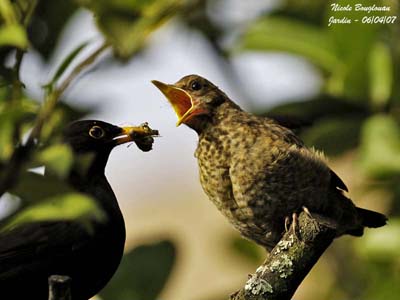
DIET:
Common Blackbird feeds mainly on mature cultivated fruits such as apples, pears, sherries, strawberries, grapes… It also consumes wild fruits and berries. It catches insects, spiders and earth worms, and takes some seeds too, while hunting on the ground.
PROTECTION / THREATS / STATUS:
Common Blackbird is considered as pest in orchards in Australia and New Zealand, because it damages natural ecosystems.
It has several natural predators such as domestic cats, foxes, birds of prey and corvids.
Fr: Merle noir
All: Amsel
Esp: Mirlo Común
Ital: Merlo
Nd: Merel
Russe: дрозд
Sd: Koltrast
Text and pictures by Nicole Bouglouan
Nicole Bouglouan
PHOTOGRAPHIC RAMBLE
Sources :
Handbook of the Birds of the World by Josep del Hoyo-Andrew Elliott-David Christie Volume 10 - Lynx Edicions - ISBN: 8487334725
Pájaros de España (JL Beamonte)
Wikipedia (Wikipedia, The Free Encyclopaedia)
Reproduction of the Common or Eurasian Blackbird in the garden
